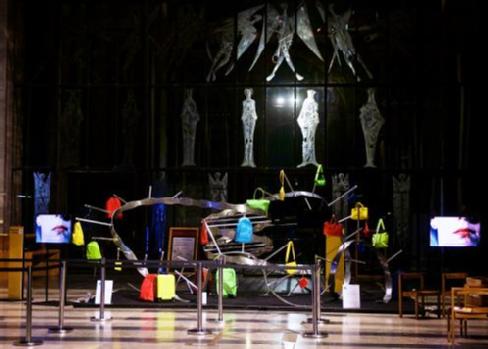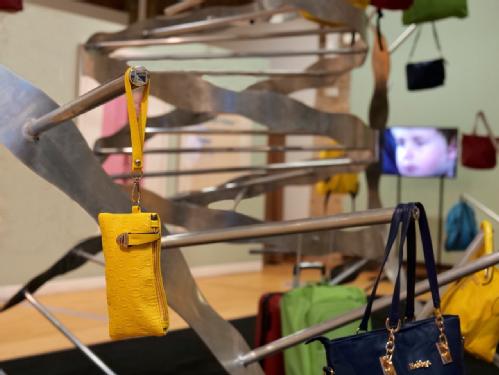I:DNA - Translating research into an art
Background
I:DNA is a Wellcome Trust funded project that was created to engage the public with research led by Professor Felicity Boardman, in conjunction with Dr Corinna Clark, at Warwick Medical School. The research explores the experiences of people living with inherited conditions and their attitudes towards genetic medicine.
This video provides an overview of the art installation produced to explore these themes. You can read more about the project as a whole here.
Translating research into an art
The complexity and nuanced nature of the debates around genetic screening, and the range of differing viewpoints, meant that we spent a lot of time during the development of the installation discussing how to balance providing sufficient information to engage and stimulate discussion, without either over-loading the audience or presenting complex social and ethical issues superficially. Allied to this discussion, throughout the whole process, was the delicate balance between the creative art side of I:DNA and the research engagement side.
 From our perspective as researchers, our priority was to engage the public with the research and empower them to reflect on the various perspectives surrounding genomic medicine highlighted, which they had likely never encountered before. In line with this, fairly representing the powerful words of the research participants and including all the perspectives was important to us, both for avoiding bias and ensuring accuracy.
From our perspective as researchers, our priority was to engage the public with the research and empower them to reflect on the various perspectives surrounding genomic medicine highlighted, which they had likely never encountered before. In line with this, fairly representing the powerful words of the research participants and including all the perspectives was important to us, both for avoiding bias and ensuring accuracy.
Our creative partners approached the creation of I:DNA through a different lens. As artists and specialists in digital production, STAMP CIC’s focus was primarily on creating a thought-provoking and artistically credible installation.
These two contrasting standpoints informed the creative process in various ways and there were points over which both parties felt that they could not compromise, meaning that there were sometimes disagreements in the way in which I:DNA was envisioned.
One example of a difference in perspective concerned the inclusion of the sung aspect of the soundscape to accompany I:DNA. The creative team were clear that this should be a feature of the installation to communicate the research data to audiences without the monotony of using only spoken word. The researchers were more reticent about the use of song and the possibility that music could obscure or otherwise misrepresent the meaning and tone of the verbatim quotes from research participants. In particular, we were concerned that the use of song could trivialise, or introduce inappropriate levity, to sensitive issues (e.g., pregnancy termination, life-limiting health issues). Following extensive discussion between the research and artistic teams, we eventually reached a compromise, whereby a large proportion of the soundscape was sung, but musical arrangements that we (the researchers) felt were inappropriate were removed and instead spoken by actors.
In these circumstances, it is important to acknowledge and respect the different perspectives and expertise – both creative and scientific/research – of the team to find a mutually acceptable solution. Ultimately, despite our different approaches, we were all working towards the same goal, that of engaging the public with a complex ethical debate. It is vital not to underestimate the importance of this working relationship and fostering a truly collaborative environment of open and respectful communication. Choosing collaborators is a crucial part of the process, as is ensuring that all team members clearly understand the overall goals, feel that they have a voice in the creative process, and are able to challenge decisions or views.
 The importance of reaching a balance between art and research1 and the difficulties that can arise in these collaborations have been documented in the literature 2,3,4,5. While arts-based engagement has the capacity to translate data and ‘bring it to life’ in a way that more traditional forms of science/research communication may not, there is an inherent risk to the researcher from relinquishing control of the interpretation of their research data3. Bartlett (2015)3 discusses the potential for the research message to get lost or overshadowed by an artistic agenda or endeavour. As well the intended ‘message’ being diluted through the creation of artwork, the very nature of art as a personal and interpretive experience can also mean that audiences come away with very different understandings from those intended by its creators. This can also be compounded by the setting in which the installation is displayed eliciting unexpected responses (see Finding your audience and Putting on an event). It is also important to consider that artistic endeavour is not universally accessible, as some members of the public will choose not to engage with particular (or any) forms of art. Ball et al (2021)2 provide a good summary of the different art-forms that have been used in public engagement and how these may be influenced by the context and audience.
The importance of reaching a balance between art and research1 and the difficulties that can arise in these collaborations have been documented in the literature 2,3,4,5. While arts-based engagement has the capacity to translate data and ‘bring it to life’ in a way that more traditional forms of science/research communication may not, there is an inherent risk to the researcher from relinquishing control of the interpretation of their research data3. Bartlett (2015)3 discusses the potential for the research message to get lost or overshadowed by an artistic agenda or endeavour. As well the intended ‘message’ being diluted through the creation of artwork, the very nature of art as a personal and interpretive experience can also mean that audiences come away with very different understandings from those intended by its creators. This can also be compounded by the setting in which the installation is displayed eliciting unexpected responses (see Finding your audience and Putting on an event). It is also important to consider that artistic endeavour is not universally accessible, as some members of the public will choose not to engage with particular (or any) forms of art. Ball et al (2021)2 provide a good summary of the different art-forms that have been used in public engagement and how these may be influenced by the context and audience.
We concluded that our approach was largely successful, with evidence of visitors engaging with the topic, gaining knowledge, and thinking about how the issues could affect their own lives.
“I didn’t expect it to be as emotional as it was. The music and words were both poignant and hopeful, you can’t help but be moved by them” (Visitor I:DNA, Oxford Science and Ideas Festival)
“It has allowed me to look from a new perspective about something I have not fully thought about. The effect of genetic disorders in families - it's a difficult one and it is useful to be able to have this new perspective.” (Visitor I:DNA, British Science Festival)
Some visitors did report that they didn’t ‘get’ what we were trying to say or felt that some of the artistic aspects of the installation were distracting or diluted the message.
“I wasn't sure what the message was. At places, it looks like a positive one, but the music and tones and at times the speakers felt negative” (Visitor I:DNA, Millennium Point)
“Once I had had the baggage explained, I could really appreciate the purpose of the exhibition” (Visitor I:DNA, Coventry Cathedral)
There is a comprehensive discussion of this, including more quotations from our visitors, in our paper [link].
1Chilton and Leavy, 2014. Arts-based research practice: merging social research and the creative arts. In The Oxford Handbook of Qualitative Research (1st ed). Ed by Leavy. DOI: 10.1093/oxfordhb/9780199811755.013.003
2Ball et al, 2021. Arts-based approaches to public engagement with research: Lessons from a rapid review . Santa Monica, CA: RAND Corporation, 2021. www.rand.org/pubs/research_reports/RRA194-1.html.
3Bartlett 2015. Visualising dementia activism: using the arts to communicate research findings. Qualitative Research 15(6) 755-768
4Drumm et al., 2015. The Aeolus project: Science outreach through art. Public Understanding of Science 24(3) 375-385
5Tischer et al., 2020. Using art for public engagement: reflections on the Dementia and Imagination project. Arts & Health, 12(3) 270-277
